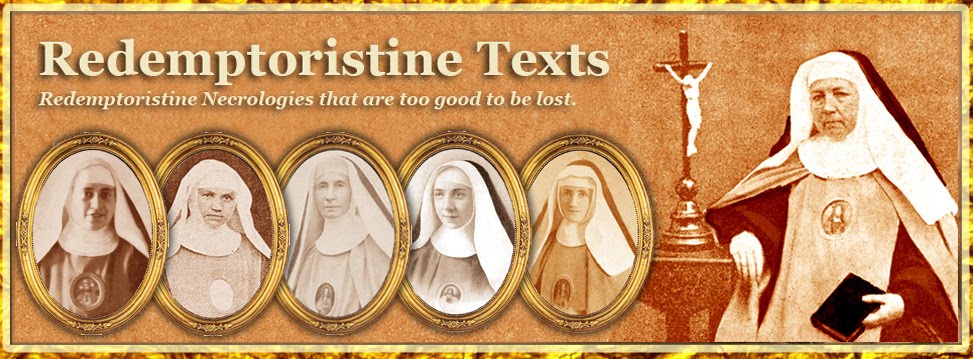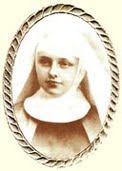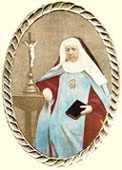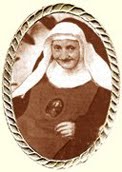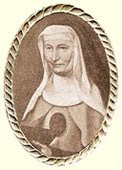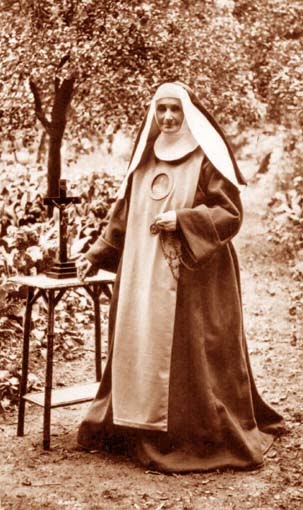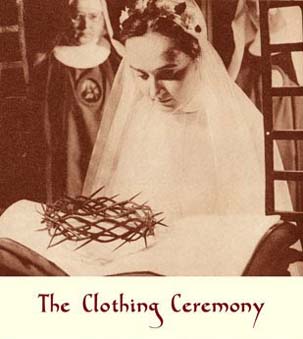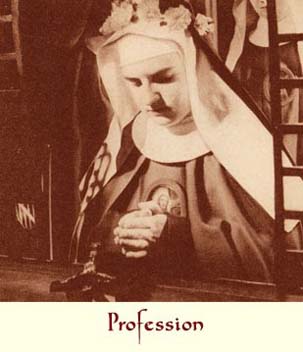Foundress of the Convent of the Redemptoristines of Velp, near Grave, founded in 1858
Chapter V. The new foundation.
After the Revolution of 1848 most of the countries of Europe did not cease to find themselves in a situation of uncertainty and trouble. Liberal governments, while proclaiming themselves to be the defenders of liberty for all, granted this liberty to all the sects but refused it to the Catholic religion, which they tried to oppress in every fashion.
This was the case in Belgium. There they bore down especially upon religious Congregations, which they said deceitfully, were working against the progress of civilisation and did no more than spread ignorance and “bigotry” everywhere.
The result for the religious was difficult and perilous times against which they had to defend themselves. And then in 1857 the Belgian parliament passed a “law against religious”, which was soon reduced in practice to Brussels, Antwerp and a few other places.
The Redemptoristines of Bruges feared with good reason that they would be troubled in their situation which had hitherto been peaceful, and Mons. Malou, the Bishop of Bruges, believed he had to warn them himself of the danger they were running. Filled with a paternal solicitude, it advised them to seek a place abroad where they could live at least temporarily. The good Sisters cast their eyes upon England or Ireland, but they could not then hope to find a convenient establishment in those countries.
But good Providence would once again show its predilection for the spiritual daughters of Saint Alphonsus.
At an hour’s distance from the town of Grave in Holland, there was a village of 600 inhabitants called Velp. It was a solitary place and far from the noise of the world. Dotted in the midst of the fields, the cottages and houses of the countryside could be seen. Everywhere a pleasant and peaceful calm reigned. So it was in no way astonishing that the sons of St. Francis, in the 17th century, founded a monastery in this blessed spot that still exists today.
In 1858 there was also a little manor house there which bore the name of “Bronkhorst”. The building had a considerable garden, it was all surrounded by a stretch of water, and it occupied an area of about two hectares. A distinguished Prelate, Mons. de la Geneste, a protonotary of Pius IX, was the owner. The Mother-Superior of Bruges, Marie-Philomene, learnt that this property was for sale. The circumstances in which she knew of it deserve to be reported.
In the Belgian Province of the Congregation of the Most Holy Redeemer, there was a Dutch Father of the name of Van der Meulen, the brother in law of the burgomaster of the commune of Velp. However, Mons. de la Geneste had confided the care of this property to him, and at this moment, the month of October 1857, this Redemptorist Father was back in his native country. He paid a visit to his brother in law and learnt from him that the manor of Bronkhorst was for sale.
As quickly as he could, he made Mother Marie-Philomene aware of all this, while obtaining from the burgomaster his promise to conclude the purchase from Mons. de la Geneste. But he also had to obtain permission from the Archbishop of Utrecht, Mons. Zwysen, to establish the Congregation of the Redemptoristines in his diocese.
On the advice of Mons. Malou, Mother Marie Philomene wrote to Mons. Zwysen to beg him to be good enough to consent to the new foundation. His permission, full of benevolence, was transmitted to her several months later. A short while later, the sale was concluded, and the necessary work could begin. The burgomaster took direction of it and work began straight away to turn the little manor house into a suitable convent.
Mons Malou expressed the desire for the Superior of Bruges and one of her Sisters to go themselves to Velp to supervise both the work and order things well, and the two religious were received by the burgomaster with the greatest benevolence.
On 19th – 22nd April they decided the places for the grille in the parlour, the choir, the cloister, etc., and hastened on the completion of the work to such a degree that it was hoped that the new foundation would be completely ready by the month of July.
Mother Marie Philomene was then able to inform Mons. Zwysen that she hoped to see the house put in order for the octave of the feast of the patron saint of the Congregation, that of the Most Holy Redeemer (3rd Sunday of July), in order to place under the protection of the divine Saviour the work undertaken for the glory of God and the salvation of souls. His Lordship announced his satisfaction and then, at Bruges, they were able to begin getting ready for the departure of the founding Sisters.
Mons. Malou had decided that the choice of these Sisters would be made by the Superior and her counsel. In the community, they were asking who would be the Superior of the new foundation. On this subject no one had less concern about it than Sister Marie-Cherubine, the whole time the establishment of Velp was going forward.
Finally the moment came to make the choice of the founding Sisters. On 8th July 1858, the Community assembled to hear the nominations… After the opening prayers and some preliminary remarks, Mother Marie-Philomene then pronounced the names of the foundresses. “The Superior,” she said, “would be Sister Marie-Cherubine of the Holy Spirit.” Scarcely had she heard these words than she looked around her quite astonished, as if she was looking for the Sister designated, and forgot to fall upon her knees as a sign of submission, which is what was done in such circumstances. So the Sisters sitting beside her then had to tell her: “It’s you, my Sister, so go down on your knees!” This is how little the good Sister thought that she would be charged with this task, so honourable, but so important and onerous!
The Mother Superior noticed her confusion and began to encourage her by assuring her that, if she accepted her charge through obedience and with confidence, God would support her. Her companions would also assist her by their devotion.
Her companions and fellow Sisters were:
Sister Marie-Marguerite of the Sacred Heart of Jesus (Miss Caroline Marguerite Elisabeth Van Rijckervorsel, of Rotterdam) as Sister Vicar.
Sister Marie-Anne-Josepha (Miss Caroline Dupont, of Liege).
Sister Marie-Eulalia of Jesus (Miss Marie Jougen, of Mons).
Sister Marie-Felicity of the Blessed Sacrament (Miss Wilhelmina Lefevre, the daughter of Mr. Lefevre, a professor at the University of Ghent).
Next two converse Sisters:
Sister Angela of the Holy Family (Miss Mathilda Ansieur, of Zwerssele, West Flanders).
Sister Julie de Volder, a converse educande Sister, of Hooglede, (West Flanders).
These were the foundresses of the new Monastery of Velp.
The 19th July was then designated as the day for the religious to depart. Mother Marie-Philomene herself led the little colony, which arrived at its destination on the 20th of the same month. The Dean of Velp, A. Pulzers, blessed the chapel, the house and the garden. The Holy Mass was celebrated for the first time in the new convent on the 22nd. The a great solemn Mass was sung by the Dean, whose assistants were the Redemptorist Father Van der Meulen and the Father Guardian of the Capuchin Fathers, Father Athanase. On the 26th, the enclosure was solemnly established, and the following day, Mother Marie-Cherubine and her assistant Sisters were invested with their functions by Mother Marie-Philomene.
When everything had been done, Mother Marie-Philomene returned to Bruges, on 29th July. Straight after her departure, the Sisters made their submission to the new Superior, and the community of Velp was thus constituted like all the other communities of Redemptoristines. A new career then opened up for Mother Marie-Cherubine.
This was the case in Belgium. There they bore down especially upon religious Congregations, which they said deceitfully, were working against the progress of civilisation and did no more than spread ignorance and “bigotry” everywhere.
The result for the religious was difficult and perilous times against which they had to defend themselves. And then in 1857 the Belgian parliament passed a “law against religious”, which was soon reduced in practice to Brussels, Antwerp and a few other places.
The Redemptoristines of Bruges feared with good reason that they would be troubled in their situation which had hitherto been peaceful, and Mons. Malou, the Bishop of Bruges, believed he had to warn them himself of the danger they were running. Filled with a paternal solicitude, it advised them to seek a place abroad where they could live at least temporarily. The good Sisters cast their eyes upon England or Ireland, but they could not then hope to find a convenient establishment in those countries.
But good Providence would once again show its predilection for the spiritual daughters of Saint Alphonsus.
At an hour’s distance from the town of Grave in Holland, there was a village of 600 inhabitants called Velp. It was a solitary place and far from the noise of the world. Dotted in the midst of the fields, the cottages and houses of the countryside could be seen. Everywhere a pleasant and peaceful calm reigned. So it was in no way astonishing that the sons of St. Francis, in the 17th century, founded a monastery in this blessed spot that still exists today.
In 1858 there was also a little manor house there which bore the name of “Bronkhorst”. The building had a considerable garden, it was all surrounded by a stretch of water, and it occupied an area of about two hectares. A distinguished Prelate, Mons. de la Geneste, a protonotary of Pius IX, was the owner. The Mother-Superior of Bruges, Marie-Philomene, learnt that this property was for sale. The circumstances in which she knew of it deserve to be reported.
In the Belgian Province of the Congregation of the Most Holy Redeemer, there was a Dutch Father of the name of Van der Meulen, the brother in law of the burgomaster of the commune of Velp. However, Mons. de la Geneste had confided the care of this property to him, and at this moment, the month of October 1857, this Redemptorist Father was back in his native country. He paid a visit to his brother in law and learnt from him that the manor of Bronkhorst was for sale.
As quickly as he could, he made Mother Marie-Philomene aware of all this, while obtaining from the burgomaster his promise to conclude the purchase from Mons. de la Geneste. But he also had to obtain permission from the Archbishop of Utrecht, Mons. Zwysen, to establish the Congregation of the Redemptoristines in his diocese.
On the advice of Mons. Malou, Mother Marie Philomene wrote to Mons. Zwysen to beg him to be good enough to consent to the new foundation. His permission, full of benevolence, was transmitted to her several months later. A short while later, the sale was concluded, and the necessary work could begin. The burgomaster took direction of it and work began straight away to turn the little manor house into a suitable convent.
Mons Malou expressed the desire for the Superior of Bruges and one of her Sisters to go themselves to Velp to supervise both the work and order things well, and the two religious were received by the burgomaster with the greatest benevolence.
On 19th – 22nd April they decided the places for the grille in the parlour, the choir, the cloister, etc., and hastened on the completion of the work to such a degree that it was hoped that the new foundation would be completely ready by the month of July.
Mother Marie Philomene was then able to inform Mons. Zwysen that she hoped to see the house put in order for the octave of the feast of the patron saint of the Congregation, that of the Most Holy Redeemer (3rd Sunday of July), in order to place under the protection of the divine Saviour the work undertaken for the glory of God and the salvation of souls. His Lordship announced his satisfaction and then, at Bruges, they were able to begin getting ready for the departure of the founding Sisters.
Mons. Malou had decided that the choice of these Sisters would be made by the Superior and her counsel. In the community, they were asking who would be the Superior of the new foundation. On this subject no one had less concern about it than Sister Marie-Cherubine, the whole time the establishment of Velp was going forward.
Finally the moment came to make the choice of the founding Sisters. On 8th July 1858, the Community assembled to hear the nominations… After the opening prayers and some preliminary remarks, Mother Marie-Philomene then pronounced the names of the foundresses. “The Superior,” she said, “would be Sister Marie-Cherubine of the Holy Spirit.” Scarcely had she heard these words than she looked around her quite astonished, as if she was looking for the Sister designated, and forgot to fall upon her knees as a sign of submission, which is what was done in such circumstances. So the Sisters sitting beside her then had to tell her: “It’s you, my Sister, so go down on your knees!” This is how little the good Sister thought that she would be charged with this task, so honourable, but so important and onerous!
The Mother Superior noticed her confusion and began to encourage her by assuring her that, if she accepted her charge through obedience and with confidence, God would support her. Her companions would also assist her by their devotion.
Her companions and fellow Sisters were:
Sister Marie-Marguerite of the Sacred Heart of Jesus (Miss Caroline Marguerite Elisabeth Van Rijckervorsel, of Rotterdam) as Sister Vicar.
Sister Marie-Anne-Josepha (Miss Caroline Dupont, of Liege).
Sister Marie-Eulalia of Jesus (Miss Marie Jougen, of Mons).
Sister Marie-Felicity of the Blessed Sacrament (Miss Wilhelmina Lefevre, the daughter of Mr. Lefevre, a professor at the University of Ghent).
Next two converse Sisters:
Sister Angela of the Holy Family (Miss Mathilda Ansieur, of Zwerssele, West Flanders).
Sister Julie de Volder, a converse educande Sister, of Hooglede, (West Flanders).
These were the foundresses of the new Monastery of Velp.
The 19th July was then designated as the day for the religious to depart. Mother Marie-Philomene herself led the little colony, which arrived at its destination on the 20th of the same month. The Dean of Velp, A. Pulzers, blessed the chapel, the house and the garden. The Holy Mass was celebrated for the first time in the new convent on the 22nd. The a great solemn Mass was sung by the Dean, whose assistants were the Redemptorist Father Van der Meulen and the Father Guardian of the Capuchin Fathers, Father Athanase. On the 26th, the enclosure was solemnly established, and the following day, Mother Marie-Cherubine and her assistant Sisters were invested with their functions by Mother Marie-Philomene.
When everything had been done, Mother Marie-Philomene returned to Bruges, on 29th July. Straight after her departure, the Sisters made their submission to the new Superior, and the community of Velp was thus constituted like all the other communities of Redemptoristines. A new career then opened up for Mother Marie-Cherubine.
This necrology is translated from Fleurs de l'Institut des Rédemptoristines by Mr John R. Bradbury. The copyright of this translation is the property of the Redemptoristine Nuns of Maitland, Australia. The integral version of the translated book will be posted here as the necrologies appear.
